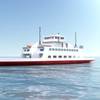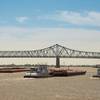Wärtsilä Integrates Spares Online With MTS
Wärtsilä has decided to cooperate with MTS within the marine e-business market and has through the MTS infrastructure integrated its Spares Online service. Spares Online gives ship owners/operators full control of their parts ordering and delivery process directly in their existing purchasing system. Spares Online keeps track of all ship owners / operators installations and provides an updated view of the equipment installed in their plant.
GE Begins Testing for LM6000 Certification
GE Transportation's marine gas turbine business has launched a program to obtain American Bureau of Shipping (ABS) certification, to the Steel Vessel and the new Naval Vessel Rules, for its LM6000 aeroderivative gas turbine. GE plans to certify the LM6000 at a power level greater than 36 MW based on U.S. Navy standard day conditions (100oF).
"The LM6000 has been operating for more than 10 years in diverse marine environments. In fact, LM6000s have accumulated more than 290,000 hours on floating, production, storage and off-loading vessels, and aboard commercial power barges and offshore platforms," said Karl Matson, general manager of GE Transportation's marine business, Evendale, Ohio. GE expects to complete the testing program and receive ABS certification in 2005.
The LM6000 was introduced in 1990, and boasts an efficiency of 41.9% at the ISO rating point. All of the 590 industrial LM6000 gas turbines in operation drive electric generators, accumulating nearly nine million hours in service with a fleet wide reliability of 99.9%. The LM6000 is the high power member of the GE LM aeroderivative gas turbine offerings. The powerful LM6000 marine gas turbine can be coupled with an electric generator making an LM6000 marine gas turbine-generator set. GE furnishes the complete marinized LM6000 gas turbine-generator set using a generator selected based on customer requirements.
Building on this record of proven reliability and looking to the future, GE has investment and technology insertion plans to grow the LM6000 well beyond its current rating without increasing the engine's shipboard size and weight footprint.
Two New Electric Shaft Systems from PMC
Prime Mover Controls of Vancouver, Canada expanded its line of electric shaft control heads.
PMC electric shaft systems are designed to ensure precise synchronization of control lever position at all stations, providing enhanced operability and increased safety. The new MCH-ES2 is the smallest twin screw electric shaft control head in the PMC product line and features full size electric shaft components.
PMC have also added electric shaft functionality to its DCH digital control head for use with the MPC-D digital propulsion control system.
New Face-Type Sterntube Seals
Wärtsilä Corporation introduced a new family of face-type seals specifically for water-lubricated stern tubes. These new Deep Sea Seals brand ManeGuard seals are ideally suited to vessels sailing frequently in coastal or other waters with high sand and silt contents. Even under such aggressive conditions, they provide robust seals with high reliability and long service intervals.
ManeGuard face-type seals are produced for shafts of 70 to 240 mm (3 to 9 inch) diameter, and are either partially split (PS type) or fully split (FS type). They are able to accept high shaft speeds up to 2700 rpm.
With ManeGuard seals, worn shafts or liners, leaking gland plates and continuous maintenance with their associated costs can be left in the past. The simplicity of their design provides maximum sealing capability for all types of water-lubricated bearings. For stern tubes with closed water systems, ManeGuard seals can be used both inboard and outboard.
The seals also have various safety features. For example, they automatically compensate for bearing wear. They also have a low magnetic signature. An inflatable emergency seal is fitted as standard. All seals are factory tested before shipping.
Bearingmaster for Two-Stroke Temp Control
The Kongsberg BearingMaster is a new bearing temperature monitoring system for 2-stroke engines. Its development follows the April 2004 launch of a new wireless monitoring system for rotary machinery applications, the GB-100 Sentry system.
It is based on the Kongsberg DataChief and AutoChief automation systems, and is designed to be the most reliable bearing temperature monitoring system available. The Kongsberg Midi Operator Station 33 (MOS 33) can be used for local display of temperatures and the GB-100 Sentry system can also be integrated to offer real-time monitoring of crosshead and crank pin bearing temperatures. Main bearing temperatures are measured by using custom designed PT100 sensors as part of the core BearingMaster system.
Designed for use on all types of Sulzer RTA/RTF engines or MAN B&W MC-C/ME-C engines, the system is as relevant to retrofit of existing engines as it is to new build vessels. In order to further facilitate ease of retrofitting, Kongsberg Maritime has formed a co-operative alliance with Goltens, who will assist in retrofit installations.
New 3500C Marine Engine Ratings
Utilizing new hardware and software designs and its change to engine with ACERT technology, Caterpillar has increased ratings for the 3500 Series marine engine family to create the more powerful 3500C-HD family. The new ratings provide higher power outputs with low fuel consumption, long engine life and reduced maintenance costs compared to most other engines in the same class.
Caterpillar’s new 3500C-HD (high displacement) 1800 rpm program features six new engine ratings that offer up to 21 percent increased power ratings compared to the current 3500B-HD Series II 1600 program (see Table 1). The new ratings meet a market need for more powerful options.
The Cat 3516C-HD engines are 60o V 16 cylinder, 78 liter, 4 stroke marine diesel engines with dry weights of about 7850 kg and dimensions of 3187 mm x 1753 mm x 1703 mm. The 3512C-HD engines are 60o V 12 cylinder, 58.6 liter engines with dry weights of 5554 kg and dimensions of 2819 mm x 1806 mm x 1703 mm.
Cat Offers Class-Approved Gensets
Caterpillar Marine Power Systems has reduced marine genset assembly bottlenecks and certification delays in the shipbuilding industry, providing vessel builders with fully certified and documented units ready for installation. Streamlining the assembly of marine engine/generator packages (gensets), Caterpillar has moved the traditional process upstream to its in-house facilities. The controlled environment ensures that assembled gensets feature standard parts and will match electrical interfaces onboard vessels.
In addition, the gensets leave the factory with Marine Classification Society (MCS) certification. MCS has certified several Caterpillar facilities for genset production, allowing the company to directly submit genset designs for approval and ensuring that the gensets are produced to MCS quality standards.
“These actions have eliminated several traditional steps in marine genset assembly and installation, making life much easier for vessel builders and owners,” says Robert Hallengren, manager European engine centers, Caterpillar Marine Power Systems.
To provide gensets featuring more consistent components, Caterpillar will be packaging all of its Cat and MaK gensets in house with MCS certification.
Prop Repair Service Extended
Wärtsilä Propulsion Netherlands (former LIPS Propellers) has extended its worldwide metallurgical propeller repair service activities. Since the introduction of a Flying Squad Toolbox Container (FSTC), metallurgical propeller repairs engineers have all professional repair tools and equipment on site to perform major propeller repairs and guarantee quality repairs. This FSTC is a 20-ft. sea container fully equipped with water cooled MIG welding equipment, measuring equipment, straightening tools, grinding/cutting machines and a power converter. Besides the equipment, all required consumables are available in the container as well as new class approved plate material (inserts).
The FSTC is currently located in Greece and has already performed over 10 jobs since it’s introduction in March 2004. Metallurgical propeller repairs with the FSTC were performed very successfully in Poland, Italy and Greece at several major ship repair yards.
Improved Engine Monitoring Available
A new user-friendly maintenance management system, CoCoS Maintenance, from MAN B&W Diesel, is designed to provide improved engine condition information providing the ability to make more informed decisions about engine management. Information provided by the system is claimed by MAN B&W Diesel to result in reduced operating costs by improved planning and optimized maintenance procedures.
Among the key CoCoS Maintenance objective are effective planning of preventive and corrective maintenance work, performance of condition-based maintenance, the creation of reports detailing resource allocation and use, efficient stock control and the correct processing of documentation as required by the classification societies.
Siemens Helps in Unique Vessel Conversion
A project nearing completion to convert a simple cargo LASH vessel into a unique, deepwater pipe laying ship will include all new propulsion and electrical distribution equipment from Siemens. Gretna, La.-based Torch Offshore’s new flagship vessel, the Midnight Express, is a 520 ft. long, DP 2 (Dynamic Positioning) pipe laying ship that will serve oil industry customers in the Gulf of Mexico. As the principle electrical contractor on the project, Siemens worked with DC Maritime Technologies of Vancouver, Canada, to supply all engineering, consulting, electrical and propulsion systems for the vessel.
The Midnight Express was a LASH (for lighter-aboard ship) vessel that loads and unloads cargo from smaller ships used for transporting cargo to or from a vessel that cannot be berthed at a pier or dock. Torch Offshore completely renovated the ship and outfitted it with a patented reel-laying system for deepwater installations. Siemens was responsible for supplying all of the new electrical distribution equipment including generators, switchboards, transformers, converters, thruster motors, starters and distribution panels. The new propulsion system includes three 2,200kW Siemens variable speed AC propulsion thruster drives and three 1,500kW Siemens variable speed drive azimuthing thrusters; two retractable and one tunnel mounted unit. A new 6.6kV switchboard distributes electrical power to both the propulsion and ship’s services. Two 6.6kV/400V/1,000kVA transformers connect the 6.6kV switchboard to the existing ship’s services switchboard and two 6.6kV/400V/1,500kVA transformers connect to a new switchboard that will distribute power to distribution panels and services required to complete the new installation. A new Siemens integrated alarm system (IAS) was also included to continually monitor these systems.
Service Agreement Safeguards Power Supply Offshore
Norwegian oilfield service company Petroleum Geo-Services (PGS) awarded a five-year service agreement to Wärtsilä covering maintenance of the power plants onboard three offshore FPSO (Floating, Production, Storage and Offloading) vessels: Petrojarl Foinaven, Petrojarl Varg and Petrojarl 1. This is an extension of the first Service Agreements between PGS and Wärtsilä originally signed in 1999. Wärtsilä has had a permanent power plant maintenance crew onboard the three vessels at all times since January 2002. During overhauls, Wärtsilä sends additional service crew to complete the job within the time required. Wärtsilä also supplies all spare parts and consumables.
Iveco Introduces New Marine Diesel
Iveco Motors Of North America introduced the NEF 370, a six cylinder, high performance engine with an electronic common rail fuel injection system. With 370 hp and weighing 1,312 lbs, the engine provides a power to weight ratio of 3.54lbs./hp.
The NEF 370’s control module supervises the engines performance and protects the engine from misuse. The better integration of electronics provides more accurate information to the skipper. The electronic installation process requires a couple of wires, making it simple and time efficient.
Subscribe for
Maritime Reporter E-News
Maritime Reporter E-News is the maritime industry's largest circulation and most authoritative ENews Service, delivered to your Email five times per week










